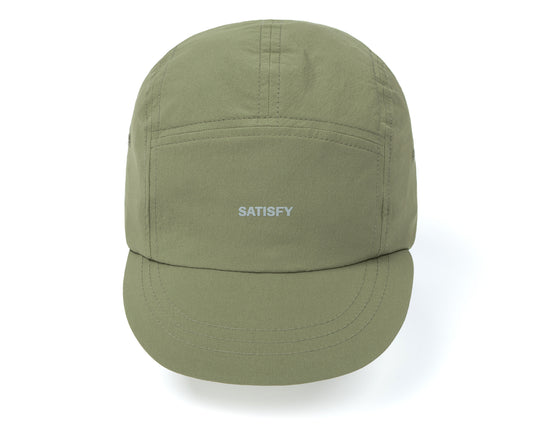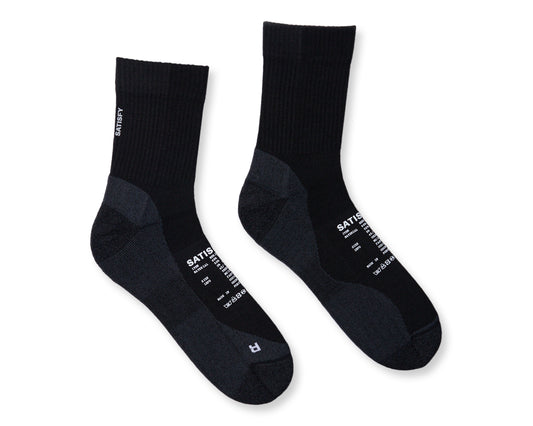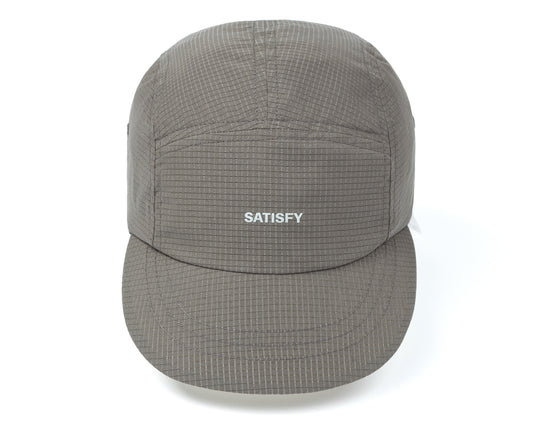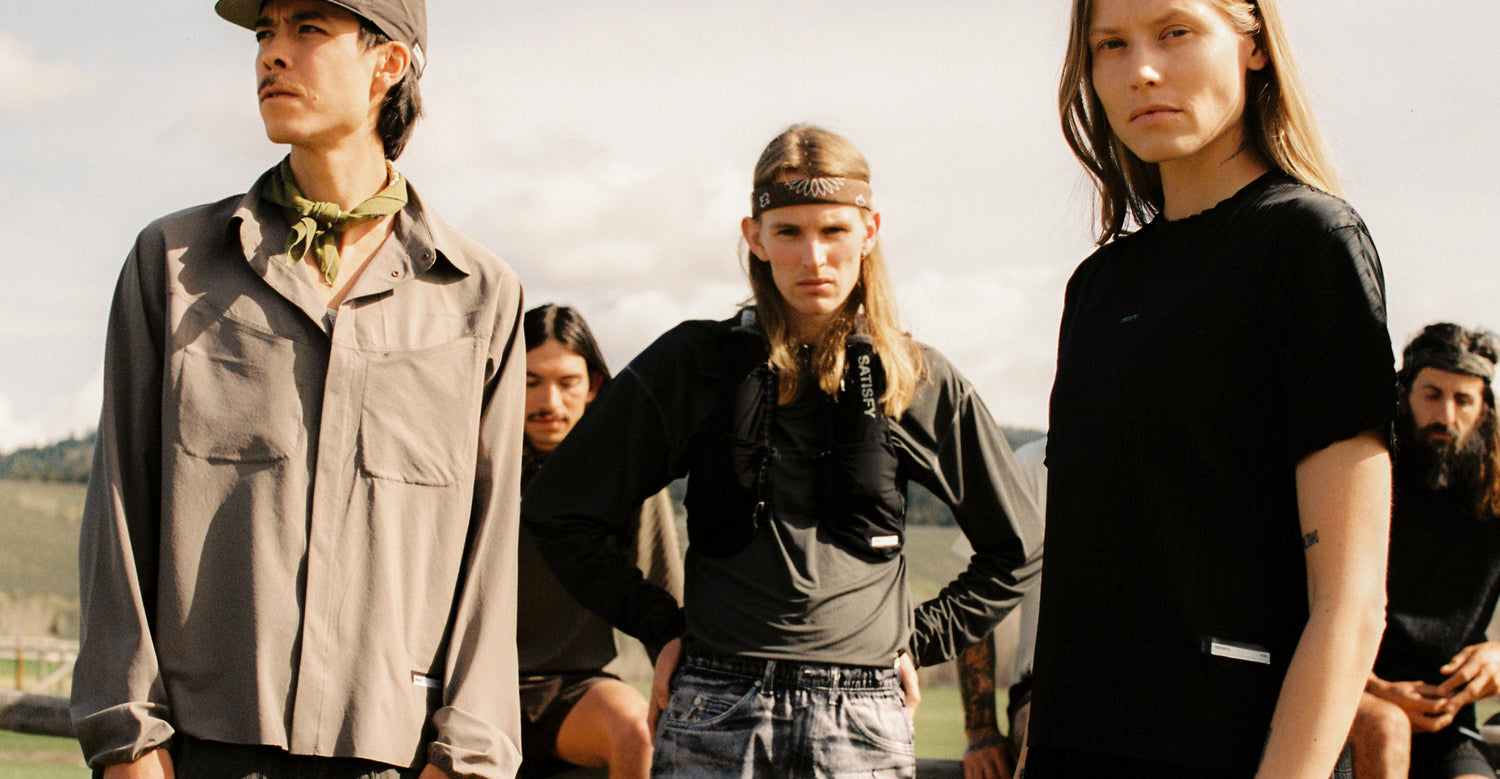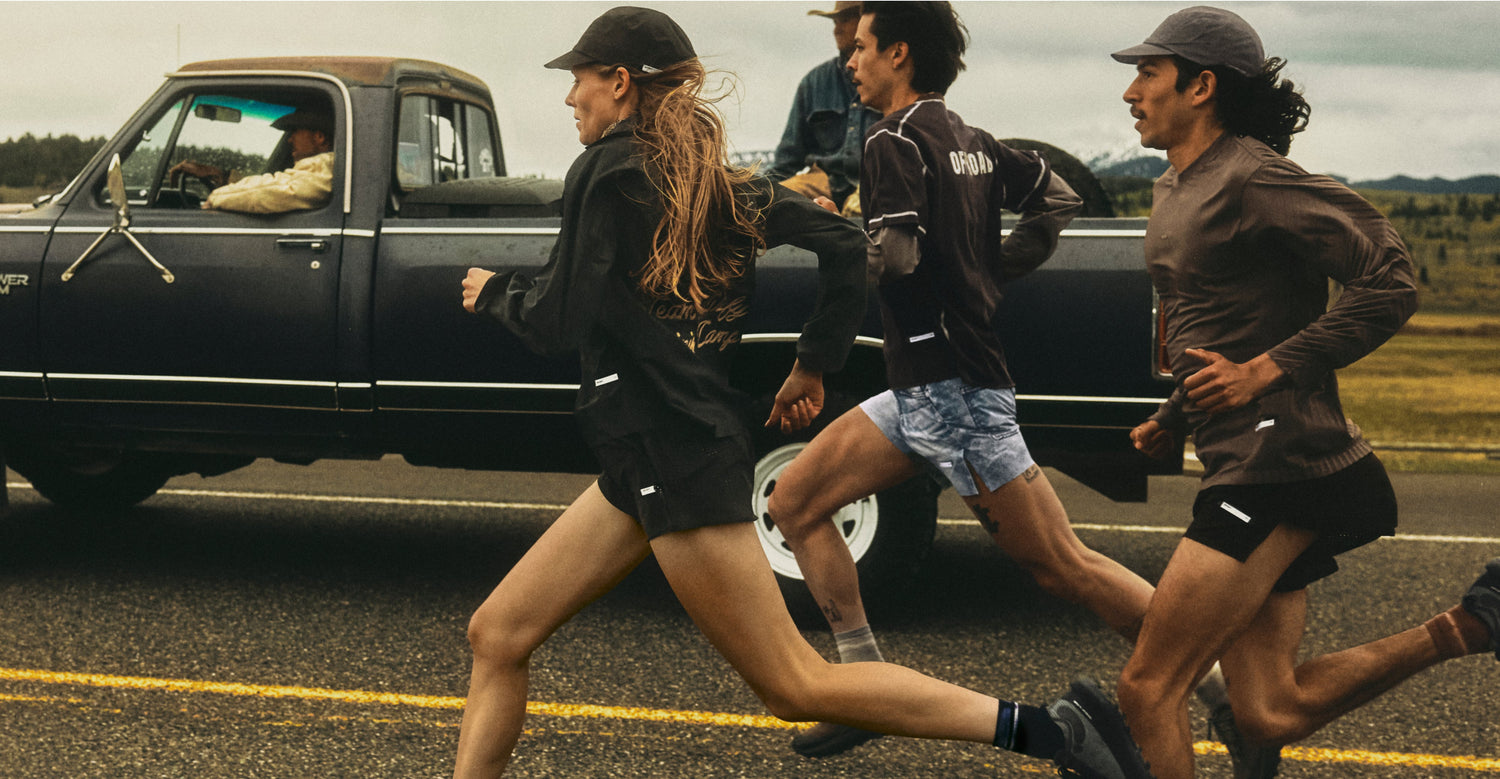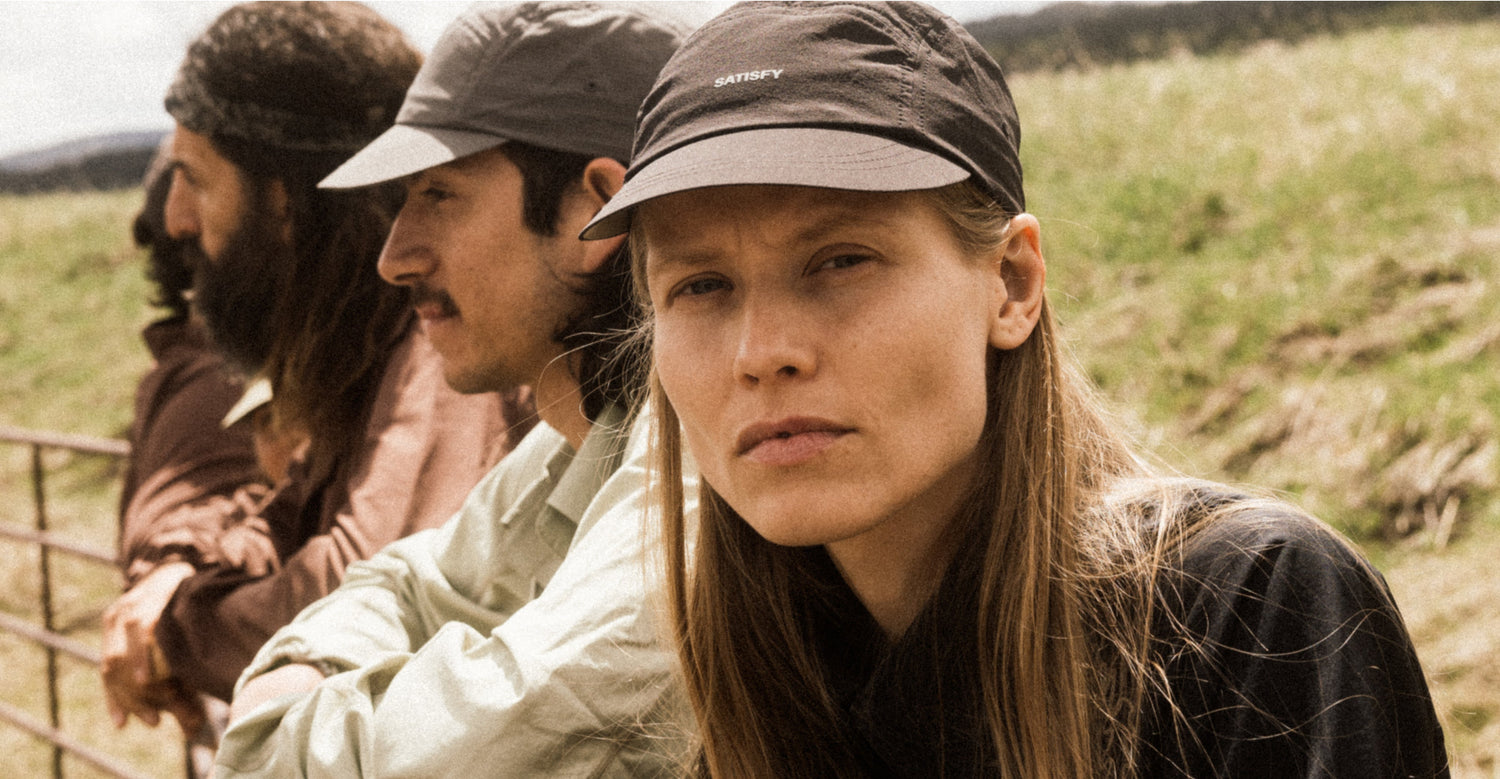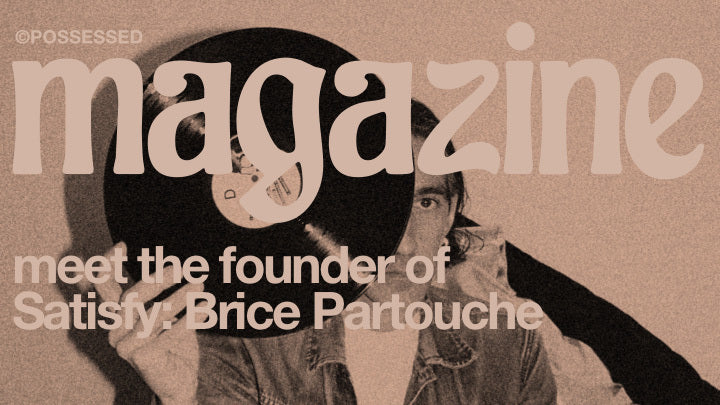
Meet the founder of Satisfy: Brice Partouche
Adam & Travis: Can you introduce yourself?
 Brice: I'm Brice Partouche, founder and creative director of Satisfy. I was raised in the Alps surrounded by mountains and got into snowboarding and skateboarding. I grew up going to flea markets with my dad, which is where I got my knowledge of vintage clothing and fabrics. My dad had a denim brand in the '80s and he basically shaped my foundation and understanding of fashion and design. But it really became a passion for me when the element of music was introduced into it. When I started to understand how bands dressed, I made the connection between all the social aspects of revolutions and youth movements. I made that connection quite early between youth rebellion, the way you dress, and the type of music you listen to. It was game changing when I started to understand this. Skateboarding with my friends meant that a lot of my music tastes were formed by skateboard videos. This is how I grew up. Then I started playing drums...
Brice: I'm Brice Partouche, founder and creative director of Satisfy. I was raised in the Alps surrounded by mountains and got into snowboarding and skateboarding. I grew up going to flea markets with my dad, which is where I got my knowledge of vintage clothing and fabrics. My dad had a denim brand in the '80s and he basically shaped my foundation and understanding of fashion and design. But it really became a passion for me when the element of music was introduced into it. When I started to understand how bands dressed, I made the connection between all the social aspects of revolutions and youth movements. I made that connection quite early between youth rebellion, the way you dress, and the type of music you listen to. It was game changing when I started to understand this. Skateboarding with my friends meant that a lot of my music tastes were formed by skateboard videos. This is how I grew up. Then I started playing drums...
Travis: What was your introduction to music?
Brice: I think it was AC/DC. Oh no, actually it was The Beatles. It was The Beatles when I was 8 and for two years I just listened to the Beatles, until I was 10. Then I discovered the Rolling Stones and then AC/DC. So yeah, it was very white dude rock 'n' roll music [laughs].
I don't like being a spectator, I'd rather be active in a scene than be passive and watch what's happening. So I guess that's why I started playing drums. But yeah, I discovered punk rock through skateboarding. Minor Threat, Black Flag, Adolescents...It wasn't just about the music. I became straight edge, was vegetarian and then vegan, all because of the music, the scene and its dream.

Adam: All these elements add up to knowing that you created a skateboard brand and then a denim brand. But how did these influences bring you to running? Before getting into running, did you already have the idea that you wanted to start a brand in that space?
Brice: I've always had a holistic vision and approach to everything that I do — whatever I see or inspires me, I relate it to a bigger picture. Even in my small music career, I always had an entrepreneurial spirit. I was always the first one to show up to rehearsals, it was always me contacting the venues to find gigs, designing and producing the merch. I like having control of things, but I also enjoy taking some risks...
I don't know if you've seen this movie, Mid-90's?
Adam: Nah, haven't seen it.
Brice: Jonah Hill directed it.
Travis: Yeah, I've heard of it but haven't seen it yet.
 Brice: So you see how the fashion, clothing, and style is so important in skateboarding culture. This is how I developed this need not just to skate, but to be part of the scene and to be creative. So when I was 16, I started my first skateboard brand called Biscuit — because I was a big fan of this hardcore band Gorilla Biscuit. I just printed a couple hundred t‑shirts and sold them to friends and the local skate shop. This was my first experience with having a brand.
Brice: So you see how the fashion, clothing, and style is so important in skateboarding culture. This is how I developed this need not just to skate, but to be part of the scene and to be creative. So when I was 16, I started my first skateboard brand called Biscuit — because I was a big fan of this hardcore band Gorilla Biscuit. I just printed a couple hundred t‑shirts and sold them to friends and the local skate shop. This was my first experience with having a brand.
Later on, I made another skateboard brand but was studying medicine at the same time. So I had to make some choices. I figured out that I didn't want to be a surgeon because I wanted to do something more creative. My absolute dream was to be doing music and to have a fashion brand. Not like a fashion brand in the sense of being a designer but rather having an entity through which I could express myself in a way that wasn't limited to music.
So yeah, my main goal was to mix music and clothing, which is what I did actually with April77 in 2000. I did that for 16 or 17 years.
Brice: I've always hated team sports. It's terrible for me. I guess that's why I loved skateboarding so much. It's not about score in skateboarding, unless you're a fan of like...
Travis: Like the X-Games or something? Which is a whole different thing. Skateboarding is more like art...
Brice: Yeah, I like the idea of no score. I guess this is why I picked punk rock and not progressive rock and I picked skateboarding and not handball — it was very popular in my hometown, to play handball.
Adam: Handball? Huh.
Brice: Yeah, yeah.
Travis: You made the right choice.
Adam: Yeah, I think so.
Brice: [laughs] So yeah, I've never really been into sports.

Travis: Did someone inspire you to run? What was the catalyst for it?
Brice: Actually, it was my ex-girlfriend. She used to run and race. In 2014, I felt the need to reinvent myself and I figured it wouldn't be too difficult for me to start running. Intellectually, I didn't consider running as a sport and physically, I had a pretty healthy lifestyle. I never tried hard drugs, was never a party animal or anything. But at the same time, it wasn't like I was super into wellness or something. I didn't really care, actually. So I didn't start running because I wanted to become fit. I guess it was something new for me that I was happy to try and I became quickly addicted to it.
Adam: Do you remember what your first run was? Where it was?
Brice: Yes, it was in Bois de Vincennes.
Adam: Oh really? That's awesome. I love it there.
Brice: I think on my first run I did 8km or something like that.
Adam: Did you have a watch on for it or anything? Or did you kinda just feel it out?
Brice: I had Runtastic downloaded on my phone.
Adam: This was probably before Strava, huh?
Brice: It was before Strava or before I knew about Strava.
Adam: So you started running a couple years before you started Satisfy?
Brice: Yes.
 Adam: Oh damn, I actually never knew that. So did Satisfy come to you as you got more addicted and obsessed with running?
Adam: Oh damn, I actually never knew that. So did Satisfy come to you as you got more addicted and obsessed with running?
Brice: Yes, I actually remember exactly when it was. At the time, every other day I was going to Bois de Vincennes at 6:30am to hit a run. One of these runs was on a beautiful day in June of 2014. I think that's the day I really became a runner. Before I was running, you know? But that day I became a runner. I experienced the High. I think when you experience the High, you become a runner. Or running finds you — something like that.
I got this moment of clarity and then I started to think about Satisfy in this context: I wanted to create running clothes that would help people who were running to become runners in this same way, by allowing them to experience or unlock the High. And this is only possible if there is a harmony between the body and the mind. Everything I had tried up to that point took away from that harmony, I had to worry about chafing, my phone, my keys — it was very distracting. So it was essential to me that my products added to that harmony. By taking what other brands consider "selling points" or something, like quick-dry and moisture wicking, as a given, it's allowed me to explore a more romantic approach on performance. That's how I was able to develop my ideas around the technologies of peace and silence.
It's something that I haven't really mentioned yet, the importance of the D.I.Y. (Do It Yourself) philosophy that guides me. When you grow up skateboarding or playing in punk rock bands, you have to do everything yourself. That's how I live. I don't wait for someone to do things for me. So with running, I just applied my number one rule: If it doesn't exist, do it by yourself.
So yeah, I think I created Satisfy on that day, starting with thinking about how I could enhance the design of running shorts and t‑shirts, and why I would do this. As I already stated, what I was using for my runs at the time wasn't great. I felt like, in my everyday life I apply aesthetic and design sensibility to the way I dress and present myself, so why should this change when I run? Why should I have to wear shitty stuff when I run? When I'm running, I'm the same person with the exact same passions for culture and love for great materials. So when I run, I should be and feel like I'm expressing who I am. I should support products and culture when I run in the same way I support products and culture in my non-running life.
 Travis: How did you come up with the name Satisfy, and what does that mean to you?
Travis: How did you come up with the name Satisfy, and what does that mean to you?
Brice: I don't remember how long it took me to find the name Satisfy, that's a good question. But I know how I found it. I was listening to Spectrum's album Sonic Boom. You know the song, "How You Satisfy Me"?
Travis: Oh yeah, wow.
Brice: Yeah, I was like, "Oh this is it." It was so obvious. Because that's the exact feeling you get after running or getting high: satisfied.
Adam: Is that what kept you coming back to running, day after day?
Brice: Yes. It really was that sensation of being high. You just want to do it again and again. This is also how I developed all the concepts for Satisfy. Getting back to the Bois de Vincennes and hitting my runs. After a month, my head was full of ideas and sketches. Whenever I'd get back home, I would transfer these ideas and sketches into a journal.
Adam: So running was like an office away from the office?
Brice: Yes, exactly.

Travis: Can you talk about that connection between creativity and when you're in that space of running?
Brice: My best ideas come to me when I run.
Travis: Same.
Adam: Same.
Brice: I don't know exactly why but maybe because during a run you settle into the natural or innate "you" and then your mindstate becomes the way it should be. So if you're a creative person, you get the best creative ideas when you're running.
Travis: What would you tell someone who wants to start running how looking back when you started running how your life changed?
Brice: For me, my life changed drastically. I prefer myself now than who I was before. I'm a much happier person since I became a runner. You can't just say that though. Not everyone can run. It's difficult, it's hard. It's not easy to run. You need first to find the trigger. For some people, it's about being fit, or stepping out of their comfort zone — there's tons of reasons to start running. But what I'd like to say is that running is a reaction to external stimuli. It's like art — when you do art, it's a reaction to something. It's the same for running: when you run you're reacting to something.
Travis: How did you assemble the people you work with at Satisfy?
Brice: When you build a team, you need to have a very precise idea about what you want and where you're going. No one will follow you if you have a half baked dream. You need to offer something that will bring people on board. I started with people I've been working with for a long time. It's been great.
For example, I work with Kristoff, he was the singer of my band in 1998. Kristoff does all the product packshots. My friend Yves does all the ecomm model pictures. He's from Grenoble and we used to skate together. You, Travis, I met a few years ago. I was a big fan of Buddyhead, your music magazine in 1999 — I won't say blog [laughs]. And Anne, Kotaro, Jeff and Tommy — I met them at April77.
Travis: So can you tell the people how many people do work at Satisfy?
Brice: Including myself and you guys, there are 9 of us.
Kotaro is our pattern maker and develops our products. From the beginning, it was very important to me that all the products would be developed in house. We have this very unique way of developing products. Most activewear brands just send measurements to factories and the factories make samples. But what we do here is we make the actual pattern, develop the fabrics, pick every single accessory. Every detail is picked here in our atelier. Kotaro is kind of like a magician. He transforms my drawings and visions into an actual product. He spends up to a week just constructing a single pair of shorts in the atelier. It's really important. Product development is key and the fact we develop everything in house is even more important. This way we can control every part of the process.
Jeff is our Art Director, in charge of graphic design, imagery, photography and videos.
 Anne is a graphic designer and designs our drops and essentials with me.
Anne is a graphic designer and designs our drops and essentials with me.
Then we have Raphael, who is our COO and in charge of all operations, business development and ecommerce. Jeff introduced me to Raphael knowing he would be a great addition to the team.
Angele joined us recently and is in charge of production. She has the challenge of ensuring the drops arrive on time.
And you guys. It's been great working with you guys. I mentioned earlier how I met Travis but we met you, Adam, through Instagram, of all places. When we brought you to Paris and I got to meet you in real life, I knew that there was something you could bring to the table and it's been really cool giving you the space to develop your skillsets.
Oh, and of course there's Tommy, who is in charge of PR, dad jokes and making rad heavy metal and Zambia rock playlists. I met Tommy when he was 19, in 2004 or 2005.
It's a great formula when everyone in the company can grow the way they want to. Normally you hire someone for a specific position or skill but I want everyone to feel they can push and explore the boundaries of their abilities. We're a start‑up, so we want to bloom — if you can do more than you are required to do, it's beautiful. I want people to have the freedom to fully express their potential. I think this is how we manage to keep the team very, very small. All of us have very wide range of skills.
I'm really proud of our team.

Adam: It's one thing to start a running apparel brand, and you've described the process of arriving at creating these products. My introduction to the brand was when I came to Paris for fashion week and helped run the showroom. It's pretty unique for a running brand to be a part of fashion week in this way. So my question is, did you always intend for Satisfy to sit at the intersection of technical performance gear and high fashion? Or was it something that just kind of came about organically as you were putting together the products and developing the fabrics and technology?
 Brice: The main idea was never to be at this position between high fashion and performance. I always had in mind to make the best products for running, so we are definitely an activewear or running brand, you name it. The fact we happen to be at the intersection with high fashion is simply that the people from the fashion industry love our products and how they look. That's really it.
Brice: The main idea was never to be at this position between high fashion and performance. I always had in mind to make the best products for running, so we are definitely an activewear or running brand, you name it. The fact we happen to be at the intersection with high fashion is simply that the people from the fashion industry love our products and how they look. That's really it.
The other thing was that my goal was to bring running culture into designer stores. Not because no one had done that before, which they hadn't, but to me it was important to bring a wellness element into these retail spaces. The high fashion and running thing though, we didn't intend to do this, it wasn't a strategy.
The idea was — and still is — to push the function and design as high as possible. Imagine a mix table and you have a function knob and design knob, and you push the two buttons all the way up without hearing any clipping or buzzing. That's how I think when I make any product: performance level and design level, all the way up. But the design level is just subjective, what is cool to me maybe isn't for you. But performance isn't subjective. It's science and technology. And you can't fuck with science [laughs].
Travis: That's true, you can't. I know it's a super involved process, but what is the simplified version of how an idea in your head becomes a product in a customer's hands? What care goes into it along the way?
Adam: And actually, a pre-question leading into Travis' question: you mentioned how people in the high fashion/couture space gravitated to our products on their own. What were those initial prototype pieces you made that started this? And then yeah, the second part is what Travis said, what is the process from zero to the pieces being produced.
Brice: The first prototype was a pair of shorts. Because again, it was from having bad experiences with all the shorts I tried so I was like, okay I'm going to try to make the best shorts ever. In a certain sense, it was actually not so hard. I mean, of course it took time and energy and hours and hours of conceptualizing and work. But in terms of finding or developing the products, it was easy because of my experience in this industry. Even when I was making denim, I was always inspired by and paid attention to new fabrics and technology, even if I wasn't using them at the time. So I knew about these fabrics, that they existed, and how to find them or develop them.
The fact that I became an obsessive runner really helped because I knew exactly what the problems were in the industry. I was also sure that these issues I experienced on my runs, I couldn't be the only one who felt this way. So the performance aspect — I knew how to make good shorts. But I needed a whole team to help realize the project, which kind of started when Kotaro joined the company. We'd have discussions, standing behind a big table covered in fabrics and creating mockups and various prototypes. It took like 8 months to make the first pair of shorts.
 Adam: Which ones were they?
Adam: Which ones were they?
Brice: They were the Short Distance 8" Shorts in all black. They actually aren't too far from what we still do now. We've evolved with better fabrics and developing our own fabrics. And we introduced the double waistband two years after our first drop. But you can recognize them as Satisfy shorts.
I found running very conservative — all other brands were only talking about score and performance and playing the game of low prices. So the challenge was feeling out if the running community was ready for a disruptive brand that would alter its perception of running, and whether or not they would be receptive to the luxury dimension of Satisfy. The products are made in Europe with the best fabrics, in premium factories with ethical labor. The fabrics that we use are normally used for the elites — the Olympians, the marathoners, the athletes that compete professionally. This kind of technology wasn't available to the running community before. What we did essentially was a change of scale that allowed us to make these fabrics and technologies accessible to the community.
Adam: I think a byproduct of your methodology in design and production is this very real aspect of sustainability—small quantities, labor contained within Europe, the best fabrics. Was sustainability a deliberate part or something that just kind of happened accidentally as a result of your process?
Brice: Yes, of course. It was deliberate. Most people think sustainability is just all about the type of fabric you use. No — sustainability is not just that. When you're in the activewear industry, most of the fabrics are polyamide and not monofibers. As much as we can, we use natural fibers. We are the first running brand that is pushing cotton for running. Our Moth Eaten T‑shirts are made of 100% organic and recycled cotton. We also have our Cloud™ Merino, which is the lightest natural wool fiber in the world.
We also meticulously manage our stock. The fact we do very small quantities makes it very sustainable because when we do drops, they are limited which means the products don't go on sale. The problem with the industry is that brands are overproducing and when you overproduce, it means there is a problem. In that way, our supply model is very sustainable too. Plus the fact that when we buy fabric in Japan, we produce in Japan; when we buy fabric in Europe, we produce in Europe. This minimizes our carbon footprint.

Travis: How do you come up with the ideas on what to focus the drops on?
Brice: We first come up with the content and then we develop the products around the content. We start with a strong story — it could be the story of Patrick Stangbye running in Oslo; it could be the story of runners from California; it could be a collaboration with an artist, band or brand we like — we start with the content and storytelling then develop the products around this story. It's kind of like a merch table. When you go to a concert, the band is the experience. And then if you loved the experience, at the end of the show you're probably going to go to the merch table and buy a t‑shirt from the tour, a souvenir. And I feel the same with Satisfy. The experience is the experience of running, of getting high. And the products we make are the merch for this experience. The difference from music merch is that our merch is not only carrying cultural value, but also is created with the best technology that will help you experience the High and run longer with less physical distraction. So it's all about the experience — this merch is going to help you enjoy the experience of running.
 Travis: What are the requirements for the stories you base the drops on? Is it just stuff that moves or excites you?
Travis: What are the requirements for the stories you base the drops on? Is it just stuff that moves or excites you?
Brice: For sure, it has to excite us. It's definitely partly personal for me but then is also based on what we talk about together as a team. It depends. We have two types of drops: collaborative drops, which are based on my passion for art or music; then drops based on the experience of a moment. In both cases, our drops always feature our signature technologies and styles.
Travis: What advice would you give to someone looking to start a brand?
Brice: A brand starts with a dream, a product and a community. It's not just about the product, it's about what people can become using the product. As Ian MacKaye says, "Never mind what's been selling, it's what you're buying." For Satisfy it means you're not just buying a pair of shorts, you're buying the culture of running — you being or becoming a runner.
Adam: In this same vein, our Magazine is all about our community. What was the inspiration for us to move in this direction?
Brice: Brands are not people, brands are brands. A tone can only be brought to a brand by people, and having this magazine gives Satisfy a tone. This is what I really like about having you guys working on Possessed, because you guys have a tone and to me this is very, very important. The idea was my friend Ian Rogers' and so far it's been great... right? I don't know, what do you guys think?
Adam: I hope so too.
Travis: I think we've done okay so far...
Brice's playlist on Spotify and Apple Music.
Images by Pierre David.
